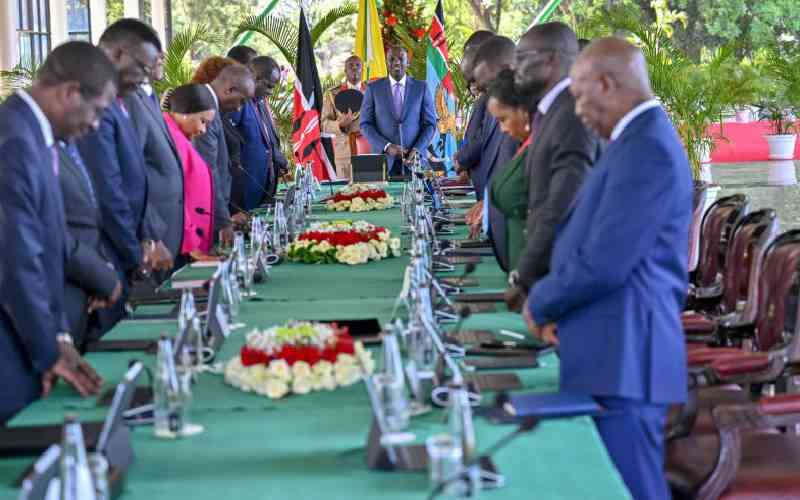
A battle royale awaits the tabling in Parliament of the 2023/24 budget proposals by Finance Cabinet Secretary Njuguna Ndung'u on June 15, unless a way out is found before then.
Opposition legislators have their guns already drawn and blazing, and are digging in for a fierce battle of wits on the floor of the two houses.
The government side is not to be left behind, promising the mother of all fights to ensure that the budget proposals are passed by Parliament without any amendment. This push-and-pull in a matter of national importance is unnecessary, and uncalled for at this time when there is so much at stake in the country.
The cost of living is already through the roof and surging, and Kenyans cannot afford to wait any longer for a reprieve in the cost of basic foodstuffs, transport and other necessities of life. Unfortunately, the politicians seem to prefer an adversarial approach to legislation where the tyranny of numbers counts more than the issues at stake.
As a country, we need to engender a culture of consensus building across the political divide to ensure that while the strong get their way, the weak have their voice heard. In the current situation, consensus building is needed to avoid either throwing the baby with the bath water-if the opposition carries the day-or romping home with monumental mistakes in the budget proposals, if the government side takes the day. In my view, this process can be navigated by first developing goodwill to make it possible for the government and opposition to agree to build consensus on fundamental issues to be discussed at a Kamkunji-like engagement.
The Kamkunji should bring together key stakeholders in the budget making process, including the National Treasury, Kenya Revenue Authority, Finance and Planning Committees of the National Assembly and Senate, Parliament's budget office, State Law Office and taxpayer representatives. With the requisite technical support, the representative team should be able to thrush out the issues at stake and come up with a document that enjoys a broad consensus.
The discussions should follow a logical flow that starts with placing the contentious issues on the table, allowing the government to explain the thinking behind this year's budget proposals, then they can go into the nitty-gritty of the discussions.
- Striking clinical officers pledge free medical care during protests
- Parliament team warns of health disruptions after Bill withdrawal
Keep Reading
But, first things first. The opposition has already stated its discontents with the budget proposals. The same should be well articulated and presented for discussion.
First, the government should be given an opportunity to explain to the stakeholders its current budget philosophy; how this year's budget is meant to consolidate the national goal of financial independence and sovereignty. Such a goal is only achievable or at least pursued by ensuring less dependency on external funding for budgetary support.
The main sources of funding for the national budgets are tax revenues (i.e. income tax, customs duty, VAT, excise duty), appropriations-in-aid (monies generated by government departments through fees, licenses, permits, and other economic activities), domestic borrowing and budget support by development partners.
Taxes and appropriations-in-aid are the cheapest sources of revenue for the government as they don't need to be refunded. The next level is domestic borrowing, usually from local financial institutions and citizens, because the government can renegotiate repayment terms with them at minimal costs. So, the government must exhaust these sources of domestic financial resources before it can resort to external borrowing, which is not only expensive, but also represents a huge outflow of foreign exchange from the country.
Credit rating
As things stand now, the government is grappling with a very huge external debt portfolio that threatens the country's development and credit rating. It has been argued that a big chunk of the external debts were accumulated over the last one decade to underwrite the aggressive physical infrastructural developments that saw Nairobi and other major metropolises significantly transformed.

Kenya is currently doing a very delicate balancing act between debt repayments and further investment in development projects. Regarding domestic borrowing, it is instructive that it will necessitate an increase in interest rates. This is how it works. For the government to attract citizens to lend money to it on a short-term basis, and not save the same in commercial banks, the government raises interest rates on Treasury Bills beyond what financial institutions can offer to customers on their deposits.
This process is called open market operation. When this happens, the commercial banks and other financial institutions are denied deposits which are instead directed to the Central Bank of Kenya to buy the bills. This leads to what economists call 'crowding out effect", where financial institutions are starved of cash to lend to borrowers, thus leading to poor performance of the financial sector.
When financial institutions reduce their lending activities, households and firms have less money available to them for investment. This leads to poor economic activity. The economy produces fewer goods and services. The economy cannot create enough jobs to accommodate all the job-seekers who are leaving schools, tertiary institutions and universities. With fewer goods being produced by the economy relative to the money supply, inflation becomes a natural consequence.
Inflationary spirals
No government wants to deliberately instigate inflationary spirals beyond the levels that make economic sense. In the circumstances, increased borrowing from external sources is not only economically imprudent, but also difficult. Further indebtedness is, therefore, not a good option. Domestic borrowing is equally not a very good alternative given the poor state of the economy. Effective mobilisation of domestic financial resources, therefore, remains the most viable source of budget financing in the current situation.
That said, the government should proceed to clearly explain, item by item, the basis of choosing the specific revenue streams for inclusion in the budget, how much revenue is expected from them, the socio-economic implications of such revenue sources, and mitigation measures.
One of the contentious issues that the opposition is raising is that the government is raiding the poor man's purse by imposing more taxes on fuel and other basic needs that will have a far reaching multiplier effect on the economy, with the expected result being further increase in the cost of living.
In this regard, the government should explain to Kenyans how taxing them more in the short-run is a better option than borrowing very expensive loans at commercial rates from external sources. More specifically, the government must demonstrate, through a cost-benefit analysis that if the taxes generated from domestic sources are prudently put to use, Kenyans stand to benefit much more than when expensive offshore loans are borrowed.
I can already foresee a problem here. Kenyans have had a very bad experience with past regimes regarding the linkage between taxation and service provision. It will take a lot of convincing for Kenyans to accept that this government represents a departure from past largesse and malfeasance associated with its predecessors.
The other issue regarding the choices of budgetary items is the nature of the goods, needs they satisfy, and why choosing them for inclusion in the budget is a novel idea. Economists have many categories of goods. For our purpose, let us look at only three of them, namely, Giffen goods, Sin goods and Veblen goods. Giffen goods are low-income, non-luxury products that defy standard economic and consumer demand theory.

Typically, when the price of a product increases, the demand for it is expected to reduce. The demand for Giffen goods does not follow this rule. Instead, the demand goes up as the prices increase. This is because as the price increases, consumers begin to foresee shortage of the product. So, consumers buy more and more of it to cushion themselves against future shortages. This consumer behaviour pushes the price even further. Examples of Giffen goods in Kenya include ugali, bread and milk.
An increase in taxation of any of the Giffen goods will definitely push up the cost of living for the majority of Kenyans. The government must really demonstrate that it has run out of options for it to resort to taxing Giffen goods in a country where more than 50 per cent of citizens can hardly afford a square meal per day. At the same time, the government must leave no iota of doubt in the minds of Kenyans that it has put in place the necessary safeguards to cushion vulnerable members of society.
Sin goods are those goods whose consumption is considered harmful to society. They include beer, tobacco products, spirits, candies, soft drinks, and wines. The tax levied on them is called "Sin Tax." In Kenya, sin tax is levied in the form of excise duties. The unique characteristic of sin goods is that their consumption does not vary with price.
For example, if the price of beer is increased by Sh5, its consumption may not change. The demand for sin goods is said to be inelastic, that is, a change in price does not cause a corresponding change in demand. The government uses taxation of sin goods as a good tax policy instrument because of minimal variability between target and actual tax revenues.
Veblen goods, like Giffen goods, defy the normal operations of the supply and demand mechanism. Veblen goods are high income, luxury goods whose demand increases with increases in prices. They include luxury cars, high-end jewelry and designer clothing items.
Economists refer to them as goods of ostentation. They are consumed by the very opulent members of society. This category of consumers is capable of hitting back if it becomes apparent that the government is unnecessarily targeting them to raise more tax revenues. Consumers of Veblen goods are capable of mobilising legislators to do their bidding on tax matters.
The issue of low-cost decent housing scheme must equally be debated openly, and especially the issues of compulsory levy, target beneficiaries, role of government in the process, and who will manage the projects. These assurances are necessary to avoid long protracted court cases. There has also been talk about huge increases in customs duty on selected imported products. The government should be able to demonstrate that increased duty is meant to protect local industries by discouraging importation of second-hand products.
After the government lays bare the thinking behind its taxation plan for the current financial year, the opposition and other stakeholders must be allowed ample time to digest the presentations so that they can come up with well-considered responses to them. Then the consensus building should ensue.
At the end of it, Kenyans should get a budget that not only represents their collective objective interests and aspirations, but also makes sense to them, and has the potential to catapult the country towards attaining its Vision 2030 of becoming a middle-level income economy.
The government, on its part, must undertake to be transparent in its development priorities. Kenyans need a budget that takes care of all of them, irrespective of their ethnicity, political orientation, gender, religion or circumstances. Kenyans need an all-inclusive government; a government that they can all relate to, and consider their own.
It can be achieved through goodwill and consensus building across the political divide.Let's give consensus building a chance.
Prof Ongore teaches at the Technical University of Kenya and is a former chief manager at Kenya Revenue Authority. [email protected]
 The Standard Group Plc is a multi-media organization with investments in media platforms spanning newspaper print
operations, television, radio broadcasting, digital and online services. The Standard Group is recognized as a
leading multi-media house in Kenya with a key influence in matters of national and international interest.
The Standard Group Plc is a multi-media organization with investments in media platforms spanning newspaper print
operations, television, radio broadcasting, digital and online services. The Standard Group is recognized as a
leading multi-media house in Kenya with a key influence in matters of national and international interest.











